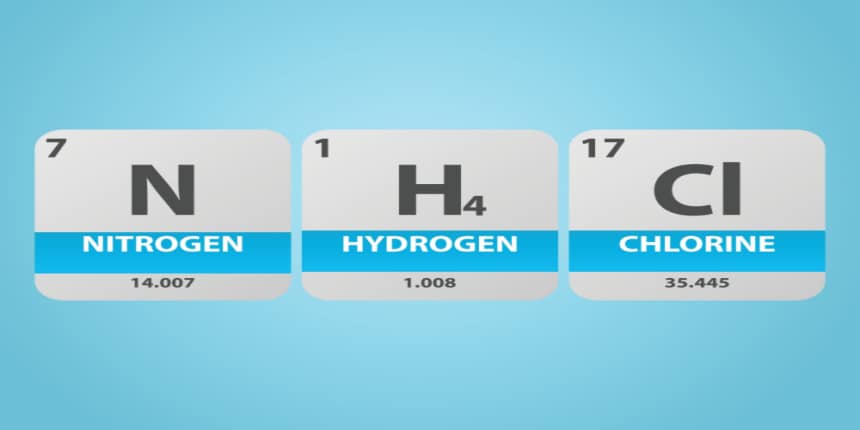NH4Cl Full Form
What is the Full Form of NH4Cl?
An inorganic substance with the formula NH4Cl, known as ammonium chloride is a white, crystalline salt that is very soluble in water. Ammonium chloride solutions have a little acidic pH(potential of hydrogen). It is referred to as sal ammoniac in the mineralogic form in which it occurs naturally. The mineral is frequently created by the condensation of gases obtained from coal on burning coal heaps. It can also be found around some kinds of volcanic eruptions. It primarily serves as a fertiliser and flavouring for some varieties of liquorice. It is a byproduct of the reaction between ammonia and hydrochloric acid.
- What is the Full Form of NH4Cl?
- Ammonium Chloride Production (Traditional Methods)
- Chemical Properties Of The Reactions Of Ammonium Chloride (NH4Cl)
- Formula And Structure
- Occurrence
- Usage Of NH4Cl
- More About NH4Cl

Ammonium chloride has purgative and diuretic properties. It is crystalline salt and white in its purest state. This substance has a high water solubility and a low acidity. In veterinary medicine, ammonium chloride is used to avoid urinary stones in sheep, goats, and cattle. NH4Cl is created when ammonium sulphate and NaCl solutions interact. The pH range of the mixture produced when ammonium chloride is dissolved in a 5% solution of water is 4.6 to 6.0 (by weight).
Ammonium Chloride Production (Traditional Methods)
It is derived from the Solvay procedure, which is used to make sodium carbonate:
That process is not only the main one for producing ammonium chloride, but it is also employed in various industrial processes to reduce ammonium leakage. In this process along with Sodium carbonate ammonium chloride is also produced as a byproduct.
The corresponding chemical reaction involved in the Solvay process that is used commercially is as follows:
2 NaCl + CO2 + H2O + 2 NH3 —> 2NH4Cl + Na2CO3
Where Ammonia and Carbon dioxide are introduced into a Sodium Chloride solution that is cold and saturated.
Ammonium Chloride is also produced from Ammonia and is prepared commercially by the reaction of ammonia (NH3) with hydrogen chloride: NH3 + HCl → NH4Cl
Chemical Properties Of The Reactions Of Ammonium Chloride (NH4Cl)
1. Ammonium chloride breaks down to create hydrogen chloride and ammonia (NH3).
Chemical equation: NH4Cl → NH3 + HCl
2. Ammonia gas is generated when sodium hydroxide and ammonium chloride combine to produce the same.
Chemical Equation: NH4Cl + NaOH → NH3 + NaCl + H2O
3. Sodium chloride and ammonia gas are formed when ammonium chloride and sodium carbonate react.
Chemical Equation: 2 NH4Cl + Na2CO3 → 2 NaCl + CO2 + H2O + 2 NH3
Formula And Structure
Ammonium chloride has the chemical formula NH4Cl and a molar mass of 53.490 g mol-1. Additionally, it exists in both the anhydrous and the three hydrate forms. Its chemical structure of it is represented below as a picture using typical organic molecule graphics.
Occurrence
Ammonium chloride, sometimes known as the "salt ammoniac," is a component of several mineralogical compositions. Additionally, it can be found in several volcanic vents and ashes.
Usage Of NH4Cl
Its main use is as an electrolyte in dry cells and as a source of nitrogen for fertilisers. It is also widely used as a component of galvanising, tinning, and soldering fluxes to remove oxide coatings from metals and so enhance the solder's adherence. Due to its effectiveness as an expectorant, it is a common ingredient in many commercial cold and cough medications. In veterinary medicine, it is also used to prevent urinary stones in goats, calves, and sheep.
More About NH4Cl
Crystalline ammonium chloride is an inert chemical. It rapidly creates a mildly acidic solution since it is extremely soluble in water. At 340 °C (644 °F), it vaporises without melting, releasing equal amounts of ammonia and hydrogen chloride. In the ammonia-soda process used to create sodium carbonate, ammonium chloride is produced as a byproduct. It can also be made by the reaction of sodium chloride and ammonium sulphate solutions. Ammonia gas is produced when slaked lime (calcium carbonate) is combined with ammonium chloride.